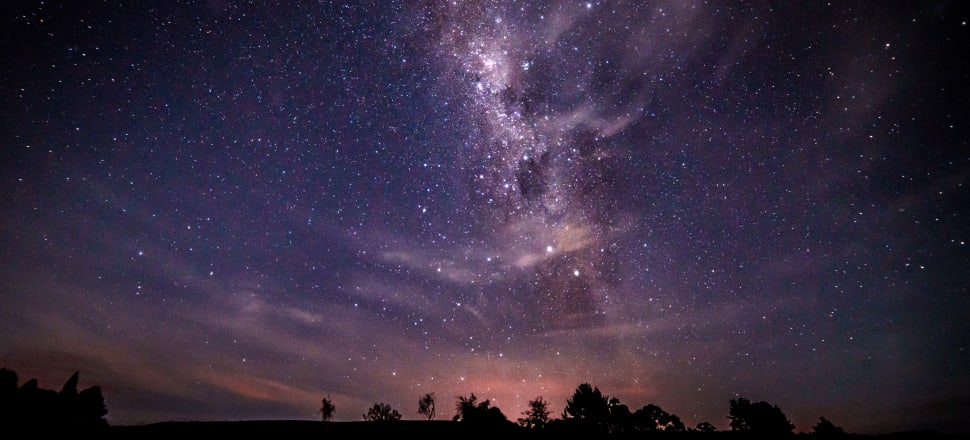
The Detail goes out after dark to find out more about the problems "light trespass" is causing for some of our precious flora and fauna
On summer nights just before dark, ecologist Annette Lees watches streams of young Cook's petrels (tītī) flying overhead on a journey that can take them thousands of kilometres from their nests.
With their inbuilt echo locators, they've flown from Te Hauturu-o-Toi/Little Barrier Island in the Hauraki Gulf, to the Tasman Sea to feed.
From her home on Auckland's west coast, Lees can also hear the goat-like bleatings of the tītī.
But as more artificial light "trespasses" into the night, Lees worries about these little grey and white seabirds.
"When they fledge from Hauturu, they're supposed to be flying off to make a world for themselves beyond in the Pacific, [but] they get attracted back to Auckland city and drawn down to the lights. They can't take off from the ground, they need a sea cliff with lots of breeze to lift their wings and take them away.
"So once they're on the ground, they can't move and they are vulnerable to cats and dogs and being hit by cars.
"It's really distressing. They're just wild creatures that are drawn to light inexorably."
Lees, the author of After Dark: Walking into the Nights of Aotearoa is taking The Detail on a night walk around her property near the Waitākere Ranges, to show the abundance of wildlife that needs darkness to thrive.
There's growing awareness of the night sky in Aotearoa, with events like Matariki and the recent launch of two new dark sky reserves in Wairarapa. But at the same time, there's increasing alarm over the spread of wasted bright light and the damage it's doing to human health and the environment, prompting calls for laws to control it.
Lees points to the range of hills silhouetted against the glow from the city - a 50 minute drive away. The light is threatening the natural biorhythms of nocturnal creatures like the tītī, bats and weta.
She calls it "light trespass", others call it light pollution: artificial street and building lights that are bleeding into rural areas.
She wants people to venture out at night more, without artificial light, to rediscover the magic they experienced as children. She believes people will become their own advocates for turning bright lights down or off.
"When they first introduced street lights back in the 1860s, they used to never run them during the full moon when it was a clear night, because it was seen as a waste of gas and then electricity.
"And now of course if it's a brightly lit moonlit night you wouldn't dream of turning off the street lights."
Ecologist Ellen Cieraad, from Nelson Marlborough Institute of Technology, studies the effects of night light on plants and insects.
Unlike other contaminants, light pollution is not regulated and its impacts on humans and other creatures are still under-researched, she says.
Her own studies show evidence of change in nature.
"For example deciduous trees, when they grow under a street light they hold onto their leaves in autumn much longer. And the same in springtime, those trees that are growing directly under a street light, the bud burst, the leaves appear much earlier.
"So those trees that are illuminated have a much longer growing season than those that are not lit up."
It may also mean grasses flower longer, which in turn may extend hay fever seasons. Cieraad says there's also a trickle-down effect from the disrupted growth of artificially-lit trees on the insects that feed on them, because the leaves may taste different.
Cieraad developed an interest in the impacts of light at night when she moved back to the Netherlands where she grew up. She discovered she could read a book outside at night under the glow of artificial light that extends tens of kilometres.
New Zealand is lucky by comparison, she says, but even here only 3 percent of the population live under a pristine dark sky and there are about 5 percent of New Zealanders whose eyes never switch to night vision, because they are exposed to bright light throughout the night.
That's a much lower figure than many parts of the world - in the Europe and US it's about three-quarters of the population - but Cieraad says the growth of bright light in Aotearoa is much faster than the global average.
Her studies show a 40 percent increase in the extent of land area that's exposed to any form of light pollution and it's getting brighter, she says.
Cieraad points to German physicist Christopher Kyba for an explanation of the impact on people.
With a 10 percent increase in night sky brightness, if a child was born today and could see 250 stars, by the time they are 18 years old, they can see fewer than 100 stars.
Hear more about the push for better protections to keep our night sky dark in the full podcast episode.
You can find out how to listen to and follow The Detail here.
You can also stay up-to-date by liking us on Facebook or following us on Twitter.








